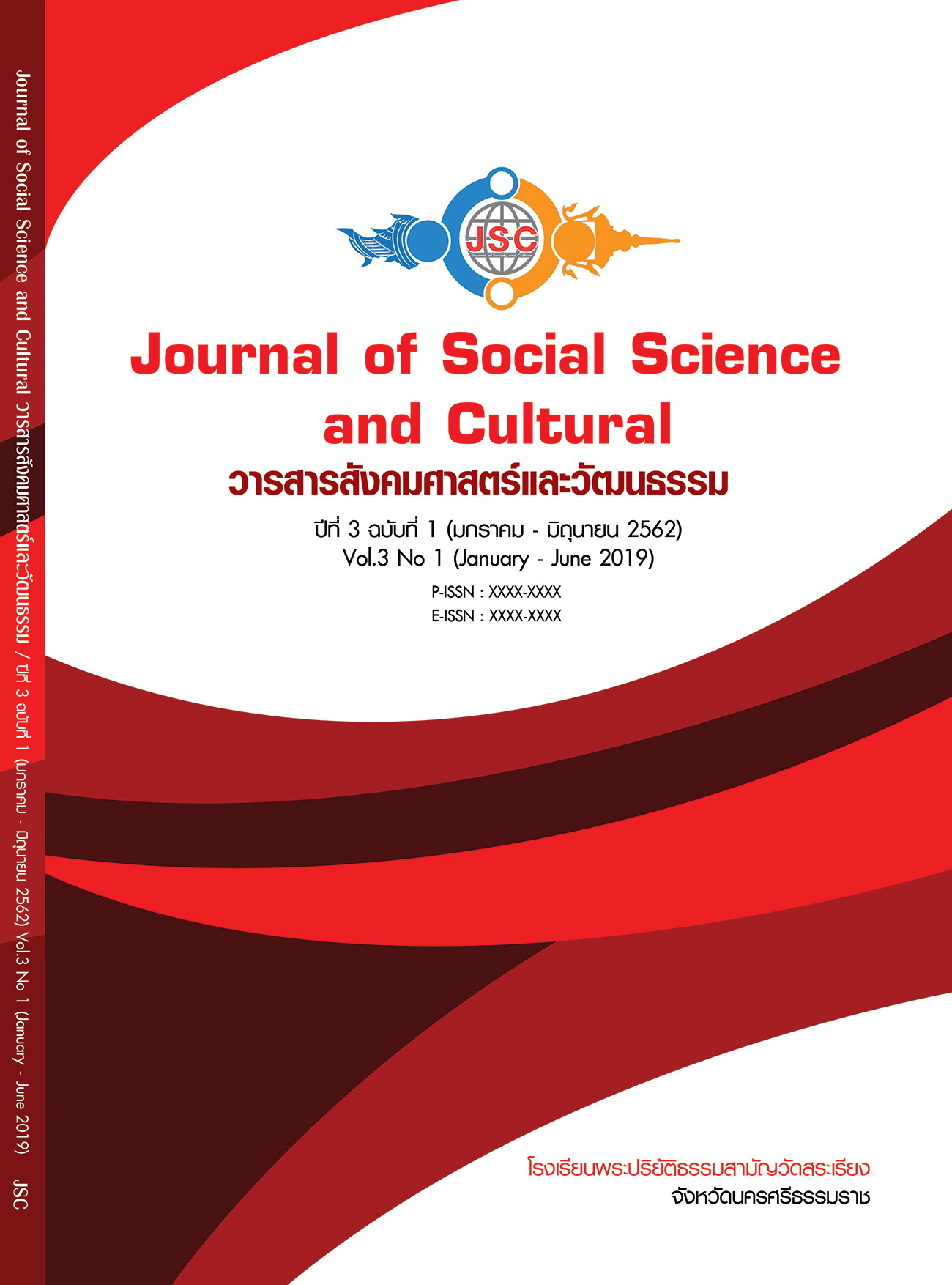FIGHTING-BULL SCHOOL AND THE FOLK WISDOM OF MANAGEMENT THE FIGHTING-BULL SPORT CAMP FOR COMMERCIAL COMPETITION, A CASE STUDY: FIGHTING-BULL STADIUM IN PAGPOL VILLAGE, NAPAKHOE, BANGKAEW, PATTHALUNG
Main Article Content
Abstract
The objective of this research were as follow: 1) to study the wisdom of raising cattle for competition, 2) to learn how to manage a sports camp bulls to trade competition, and 3) to study ways to promote the sports camp bulls to trade competition. The study was quantitative research method by the document and in-depth interviews. Select purposive sampling group to represent people with sports camps bull. It is divided into 3 groups: 1) the owner of the stadium, 2) sports camps directors, and 3) sports camp members of 14 persons. By analyzing the content and summarizing the research was found that: 1) wisdom in rearing cattle are 3 aspects: 1.1) the structure of the body, selection a bull, with strong, hardy, beautiful horn and round-clawed hooves, 1.2) parents have genuine cattle lineage, good history and complete textbooks, and 1.3) training process. Grass-eating exercise and cow butt drills. 2) The management method in business competition is that the bull-bump camp is ready, safe, rules and strict practices, from the start of the cow to the end of the collision. 3) The guideline promotion of management the fighting-bull sport camp into 4 group: 3.1) legal restrictions: bull athletes must strictly adhere to the field regulations, 3.2) Tourism promotes the promotion of sports camps and nearby attractions; 3.3) integration to conserve the development of bull sports, establish an indigenous bull conservation group and set up as a camp, and 3.4) academic information, the government should encourage people to feed more indigenous cows for agricultural.
Article Details
References
กรรมการทำหน้าที่ดูค่ายกีฬา. (14 กันยายน 2563). โรงเรียนวัวชนและภูมิปัญญาการจัดการค่ายกีฬาวัวชนเพื่อการแข่งขันทางการค้า กรณีศึกษา สนามกีฬาชนโคบ้านปากพล ตำบลนาปะขอ อำเภอบางแก้ว จังหวัดพัทลุง. (ทิพวรรณ หม้งห้อง, ผู้สัมภาษณ์)
ชมนาด ศีติสาร. (2554). ความสัมพันธ์ระหว่างคนกับวัว บนเกาะโทะกุโนะฌิมะ. jsn Journal, 1(1), 21-41.
บุญชม ศรีสะอาด. (2556). วิธีการทางสถิติสำหรับการวิจัย เล่ม 2. กรุงเทพมหานคร: สุวีริยาการพิมพ์.
ไพศาล ริ้วธงชัย และคณะ. (2548). การศึกษาแนวทางการเลี้ยงวัวด้วยภูมิปัญญาชาวบ้านเพื่อสร้างเศรษฐกิจชุมชนบ้านนาเปอะ ตำบลชาติตระการ อำเภอชาติตระการ จังหวัดพิษณุโลก. กรุงเทพมหานคร: มหาวิทยาลัยราชภัฏพิบูลสงคราม.
รงค์ บุญสวยขวัญ. (2561). การเมืองของการพนันวัวชนภาคใต้. วารสารคณะมนุษยศาสตร์และสังคมศาสตร์ มหาวิทยาลัยราชภัฎสุราษฏร์ธานี, 3(3), 241-266.
วิเชียร ณ นคร. (2545). มรดกวัฒนธรรมทักษิณ. นครศรีธรรมราช: สถาบันราชภัฏนครศรีธรรมราช.
ศศิธร บุญคงแก้ว และสิทธิพร ศรีผ่อง. (2561). การปรับตัวของกีฬาวัวชนเพื่อการท่องเที่ยว. ใน การประชุมวิชาการด้านมนุษยศาสตร์และสังคมศาสตร์ระดับชาติ ครั้งที่ 1. มหาวิทยาลัยราชภัฏสงขลา.
สุทธิวงศ์ พงศ์ไพบูลย์. (2552). วัวชนคนปักษ์ใต้. วารสารทักษิณ, 1(2), 68-81.
สุพิชฌาย์ รัตนะ. (2547). ยกระดับ "ชนวัว" กีฬาพื้นบ้าน เพื่อการท่องเที่ยว. เรียกใช้เมื่อ 20 มิถุนายน 2560 จาก http://www.nationtv.tv/main/content/378414282/
อาคม เดชทองคำ. (2543). หัวเชือกวัวชน. กรุงเทพมหานคร: สำนักงานกองทุนสนับสนุนการวิจัย.
Cronbach, L. J. (1990). Essentials of psychological testing. (5th ed.). New York: Harper Collins Publishers.


